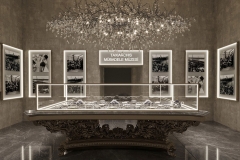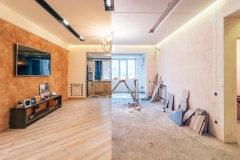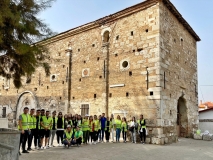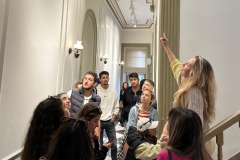
VOCATIONAL SCHOOL
Department of Architectural Restoration (Turkish)
MMIR 205 | Course Introduction and Application Information
| Course Name |
Material Deteriorations and Repairment
|
|
Code
|
Semester
|
Theory
(hour/week) |
Application/Lab
(hour/week) |
Local Credits
|
ECTS
|
|
MMIR 205
|
Fall
|
3
|
0
|
3
|
4
|
| Prerequisites |
None
|
|||||
| Course Language |
Turkish
|
|||||
| Course Type |
Required
|
|||||
| Course Level |
Short Cycle
|
|||||
| Mode of Delivery | face to face | |||||
| Teaching Methods and Techniques of the Course | Group Work | |||||
| Course Coordinator | - | |||||
| Course Lecturer(s) | ||||||
| Assistant(s) | - | |||||
| Course Objectives | Introducing building materials used in traditional architecture, explaining the use of these materials in their construction. Teaching the restoration techniques that is used in the protection and repair of traditional building materials. |
| Learning Outcomes |
The students who succeeded in this course;
|
| Course Description | To be able to comprehend the properties of traditional building materials, the types of deterioration that can be encountered in the areas used in the building and to examine their repair methods |
|
|
Core Courses | |
| Major Area Courses |
X
|
|
| Supportive Courses | ||
| Media and Management Skills Courses | ||
| Transferable Skill Courses |
WEEKLY SUBJECTS AND RELATED PREPARATION STUDIES
| Week | Subjects | Related Preparation |
| 1 | The types of materials used in traditional structures and the places they are used in the structure | |
| 2 | Explicate interior and exterior deterioration factors affecting building materials and building materials | Bernard M. Feilden, Conservation of historic buildings (Oxford ; Burlington, MA : Architectural Press, 2003) |
| 3 | Classification of material-based deterioration methods by grouping | Bernard M. Feilden, Conservation of historic buildings (Oxford ; Burlington, MA : Architectural Press, 2003) |
| 4 | Deterioration factors in stone based materials and repair methods. | Küçükkaya, A. G., Taşların Bozulma Nedenleri ve Koruma Yöntemleri, Birsen Yayınevi, İstanbul, Şubat 2004 |
| 5 | Deterioration factors in soil type materials and repair methods | Küçükkaya, A. G., Taşların Bozulma Nedenleri ve Koruma Yöntemleri, Birsen Yayınevi, İstanbul, Şubat 2004 |
| 6 | Deterioration factors in wood based materials and repair methods. | Günay, R., Geleneksel Ahşap Yapılar, Sorunları ve Çözüm Yolları, İstanbul: Birsen Yayınevi, 2002 |
| 7 | Mapping method and method of expressing the methods of interfering with visual presentation | Fitzner, B.,Heindrichs, K., Kowatzki, R., Classificationand Mapping Of Weathering Forms, 7. International Congress on Deterioration and Conservation Of Stone, Lisbon, Portegiz, 1992 |
| 8 | Deterioration factors and repair methods of metal based materials. | |
| 9 | Conservation in binding materials and mortar | Uluengin, M. B. Mimari Metaller Özellikleri, Bozulma Nedenleri, Koruma ve Restorasyon Teknikleri, Birsen Basın Yayın, İstanbul, 2006 |
| 10 | Static distortions and solution suggestions | Küçükkaya, A. G., Taşların Bozulma Nedenleri ve Koruma Yöntemleri, Birsen Yayınevi, İstanbul, Şubat 2004 |
| 11 | The stages where the building originality is corrupted and construction methods for renovation | Çamlıbel, N. Yapıların Taşıma Gücünün İyileştirilmesi, Birsen Yayınevi, İstanbul, 2000 |
| 12 | Homework- Selection of Sample Structure for Review | Eyüce, A. Geleneksel Yapılar ve Mekanlar, Birsen Yayınevi, İstanbul, 2005 |
| 13 | Student Presentations - Discussion of the methods of deterioration within the scope of the selected sample project with mapping method | |
| 14 | Student Presentations - Discussion of the methods of deterioration within the scope of the selected sample project with mapping method | |
| 15 | Review of the course | |
| 16 | Final Exam |
| Course Notes/Textbooks | Tayla, H. Geleneksel Türk Mimarisinde Yapı Sistem ve Elemanları, İstanbul 2007, Küçükkaya, A. G., Taşların Bozulma Nedenleri ve Koruma Yöntemleri, Birsen Yayınevi, İstanbul, Şubat 2004, Günay, R., Geleneksel Ahşap Yapılar, Sorunları ve Çözüm Yolları, İstanbul: Birsen Yayınevi, 2002, Fitzner, B.,Heindrichs, K., Kowatzki, R., Classificationand Mapping Of Weathering Forms, 7. International Congress on Deterioration and Conservation Of Stone, Lisbon, Portegiz, 1992, Uluengin, M. B. Mimari Metaller Özellikleri, Bozulma Nedenleri, Koruma ve Restorasyon Teknikleri, Birsen Basın Yayın, İstanbul, 2006 , Çamlıbel, N. Yapıların Taşıma Gücünün İyileştirilmesi, Birsen Yayınevi, İstanbul, 2000, Eyüce, A. Geleneksel Yapılar ve Mekanlar, Birsen Yayınevi, İstanbul, 2005 |
| Suggested Readings/Materials |
EVALUATION SYSTEM
| Semester Activities | Number | Weigthing |
| Participation |
1
|
6
|
| Laboratory / Application | ||
| Field Work | ||
| Quizzes / Studio Critiques |
3
|
9
|
| Portfolio | ||
| Homework / Assignments |
1
|
10
|
| Presentation / Jury |
1
|
10
|
| Project |
1
|
15
|
| Seminar / Workshop |
1
|
10
|
| Oral Exams | ||
| Midterm | ||
| Final Exam |
1
|
40
|
| Total |
| Weighting of Semester Activities on the Final Grade |
9
|
60
|
| Weighting of End-of-Semester Activities on the Final Grade |
1
|
40
|
| Total |
ECTS / WORKLOAD TABLE
| Semester Activities | Number | Duration (Hours) | Workload |
|---|---|---|---|
| Theoretical Course Hours (Including exam week: 16 x total hours) |
16
|
3
|
48
|
| Laboratory / Application Hours (Including exam week: '.16.' x total hours) |
16
|
1
|
16
|
| Study Hours Out of Class |
16
|
2
|
32
|
| Field Work |
0
|
||
| Quizzes / Studio Critiques |
3
|
1
|
3
|
| Portfolio |
0
|
||
| Homework / Assignments |
1
|
2
|
2
|
| Presentation / Jury |
1
|
7
|
7
|
| Project |
0
|
||
| Seminar / Workshop |
0
|
||
| Oral Exam |
0
|
||
| Midterms |
0
|
||
| Final Exam |
1
|
12
|
12
|
| Total |
120
|
COURSE LEARNING OUTCOMES AND PROGRAM QUALIFICATIONS RELATIONSHIP
|
#
|
Program Competencies/Outcomes |
* Contribution Level
|
||||
|
1
|
2
|
3
|
4
|
5
|
||
| 1 | Will be able to have knowledge about the basic technical information of the architectural restoration, methods and tools. |
X | ||||
| 2 | Will be able to transfer basic knowledge and skills about the field to the practice, will be able to interpret and transfer comments through written and oral communication. |
X | ||||
| 3 | Will be described as a restorer who is sensitive to the protection of cultural heritage, respects professional ethics and ethical values, and has knowledge of basic values of conservation. |
X | ||||
| 4 | Will be able to handle individual works in the architectural restoration filed. |
|||||
| 5 | Will be able to transmit educational knowledge into an advanced level of education or professional practice. |
|||||
| 6 | Will be acquainted with the importance of occupational health and safety, will fulfill their requirements. |
|||||
| 7 | As a required intermediate technical staff in the sector; will be able to relate collection, interpretation and announcement of the data on the architectural restoration field in the framework of ethical principles. |
X | ||||
| 8 | Will be able to communicate with colleagues and follow the knowledge in the architectural restoration field by using English at A2 General Level of European Language Portfolio. |
|||||
| 9 | Will be able to use informatics and communication technologies with computer programs in a level that required by the architectural restoration field. |
|||||
| 10 | Will be able to adopt a lifelong learning approach, and will be able to do studies for renewing and improving their knowledge continuously. |
|||||
*1 Lowest, 2 Low, 3 Average, 4 High, 5 Highest
NEWS |ALL NEWS

24 projects for a 160- year- old church
Students of Izmir University of Economics (IUE) Vocational School Architectural Restoration Program took action to make the 160-year-old Taxiarchis Church, which is

We spent the money on home improvements
People, who do not go out due to the coronavirus unless it is necessary, and who are deprived of the social life


